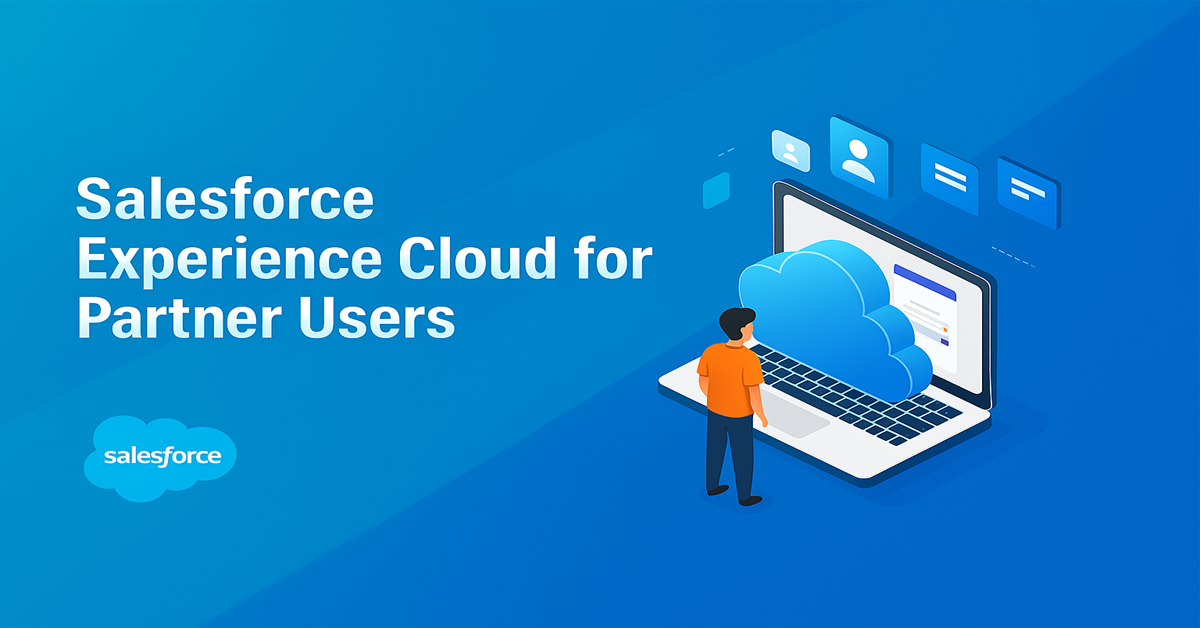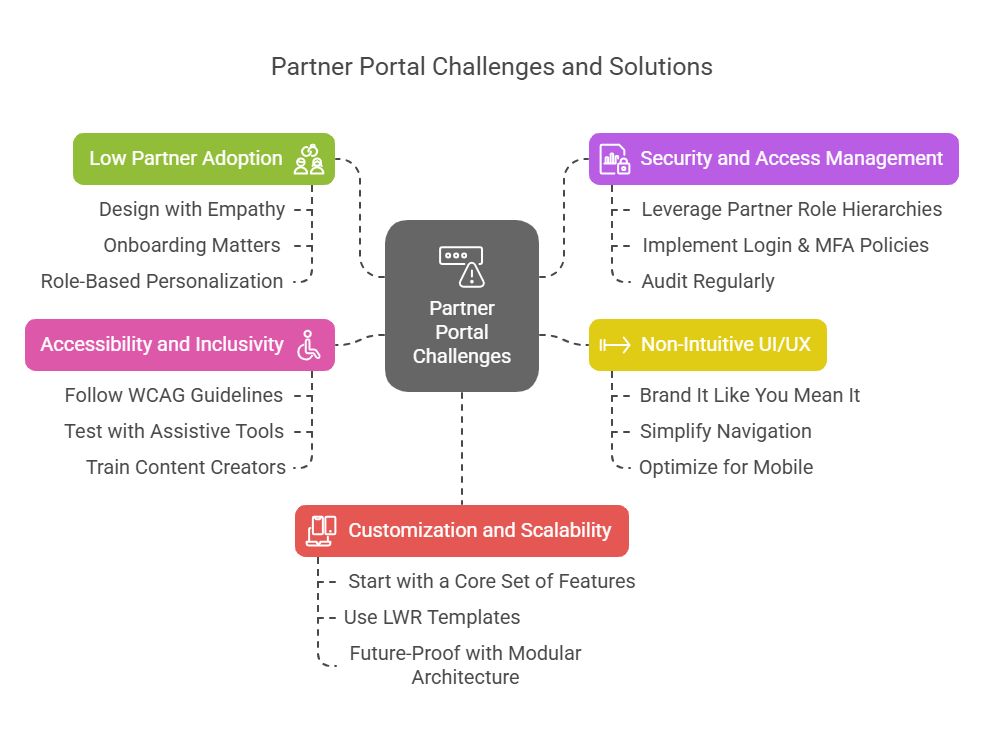Salesforce Experience Cloud for Partner Users: Implementation Challenges and MVP Strategy

Salesforce Experience Cloud is a powerful platform for building robust, scalable, and personalized digital experiences across your ecosystem, including customers, employees, and partners. For organizations with channel sales models or service alliances, implementing a partner portal using Experience Cloud can significantly improve collaboration, data transparency, and time-to-value. But like any enterprise-grade platform, success lies not in the features themselves, but in how well the solution is architected, deployed, and adopted.
In technical terms, deploying Experience Cloud for partner communities requires more than spinning up a portal and assigning roles. It demands thoughtful planning across several dimensions like identity and access management (IAM), data security and sharing rules, UI/UX design, performance optimization, and ongoing partner enablement. Missteps in any of these areas can lead to poor adoption, platform underutilization, or even security risks.
According to Salesforce’s State of Sales report, 78% of high-performing sales teams use partner portals as a key collaboration touchpoint, but 47% cite integration complexity and usability issues as top challenges. These statistics underscore a simple truth, the right tools alone don’t guarantee success. Technical implementation must be matched with strategic design choices and a deep understanding of partner needs.
In this post, we’ll examine the most common implementation challenges for partner communities and walk through best practices, including security models, UI/UX optimization, and an MVP-driven rollout strategy to help teams launch fast and scale efficiently.
Why Experience Cloud for Partner Communities?
Partner ecosystems drive significant business impact. In fact, channel sales contribute up to 75% of total revenue in many B2B organizations (Accenture). A digital experience layer like Salesforce Experience Cloud can transform fragmented communication into structured workflows.
But that transformation hinges on adoption and that’s where many implementations falter.
Key Challenges, Best Practices, and MVP Strategies
Let’s walk through some of the most common pitfalls teams face and how to overcome them with empathy, insight, and iterative thinking.
1. Low Partner Adoption
The Reality:
If your partners aren’t logging in, or worse, logging in but not engaging, it’s a red flag. According to Forrester, over 60% of partner portals fail to meet their intended ROI due to lack of usage.
Why it Happens:
Partners often view portals as extra work. If the interface is clunky, information is buried, or it doesn't help them close deals faster, they’ll go back to email chains and spreadsheets.
Best Practices:
- Design with Empathy: Treat partners like customers. Invest in user research, test wireframes with real users, and make the interface mobile-first and intuitive.
- Onboarding Matters: Companies that provide interactive onboarding see a 30% increase in engagement within the first 90 days (Salesforce Partner Experience Report).
- Role-Based Personalization: Cut the clutter. A partner marketing user doesn’t need to see sales forecasts. Use dynamic page layouts and permissions to keep the experience relevant.
MVP Tip:
Start small. Build version 1 with only the highest-impact use cases like lead registration, deal updates, or asset downloads. Let partner behavior guide your next iterations.
2. Security and Access Management
The Reality:
Security breaches or unauthorized data exposure in a partner portal can damage relationships and expose your business to compliance risks. Gartner reports that 80% of data breaches involve third parties.
Why it Happens:
Experience Cloud's flexibility can be a double-edged sword. Without a robust sharing model, you risk exposing sensitive data like leads, pricing, or opportunities to the wrong users.
Best Practices:
- Leverage Partner Role Hierarchies: Use partner accounts, partner users, and role-based visibility to ensure secure and contextual access.
- Implement Login & MFA Policies: Enforce multi-factor authentication, and integrate SSO with partner organizations where possible.
- Audit Regularly: Set up automated audits and health checks to catch misconfigurations before they become incidents.
MVP Tip:
Establish a security baseline in your first release. Focus on high-risk data models (Leads, Opportunities, Cases) and test with a small group before expanding access.
3. Non-Intuitive UI/UX
The Reality:
In an era of intuitive apps like Slack and Zoom, partners expect the same seamless digital experience from business portals. Yet only 13% of B2B portals are rated as “easy to use” by their partners (Bain & Company).
Why it Happens:
Out-of-the-box templates often look outdated or fail to reflect the partner’s daily workflows. A mismatched UX leads to frustration and drop-offs.
Best Practices:
- Brand It Like You Mean It: Customize the portal to reflect your company's identity and your partners'. It builds trust.
- Simplify Navigation: Use topics, CMS collections, and clear calls to action. Don’t make users hunt for what they need.
- Optimize for Mobile: Over 70% of partners access portals via mobile devices (Salesforce Usage Trends, 2023).
MVP Tip:
Pick one journey say, registering a lead or creating a support case and make it frictionless. Build from that success.
4. Accessibility and Inclusivity
The Reality:
A portal that isn’t accessible isn’t just non-compliant it’s exclusionary. Globally, over 1 billion people live with a disability (WHO), and your partners are no exception.
Why it Happens:
Accessibility is rarely part of initial planning. Yet it impacts everything from keyboard navigation to screen reader compatibility.
Best Practices:
- Follow WCAG Guidelines: Ensure color contrast, proper semantic HTML, alt text, and focus states.
- Test with Assistive Tools: Use screen readers (like NVDA or VoiceOver) and browser extensions to simulate real experiences.
- Train Content Creators: Make accessibility part of your content governance—not an afterthought.
MVP Tip:
Start with critical user journeys and run accessibility audits on them. Embed inclusive design practices early to avoid expensive retrofits.
5. Customization and Scalability
The Reality:
Every partner program is unique. But trying to build every requested feature into v1 often leads to bloated, unstable portals. A McKinsey study notes that over-engineered partner portals have a 40% higher abandonment rate than those built iteratively.
Why it Happens:
Organizations want to meet every stakeholder request but forget that portals must evolve with usage patterns and feedback.
Best Practices:
- Start with a Core Set of Features: Don’t aim to solve everything at once. Focus on high-value, high-frequency tasks.
- Use LWR Templates: The new Lightning Web Runtime (LWR) templates offer better performance, flexible branding, and easier upgrades.
- Future-Proof with Modular Architecture: Plan for component-based enhancements over time, not all at once.
MVP Tip:
Think of your MVP as a pilot, not a prototype. Validate assumptions, measure outcomes, and build a roadmap based on real usage analytics.

Final Thoughts
Implementing Salesforce Experience Cloud for partners is a relationship strategy. It’s how you show your partners that you’re invested in their success.
By addressing adoption challenges with empathy, prioritizing secure and accessible design, and applying an MVP mindset, you can deliver a portal that doesn’t just get used but becomes a core part of how your partners do business with you.
And remember, success isn’t measured by how much functionality you deploy but by how much value your partners derive from using it.
Ready to Transform Your Partner Ecosystem?
Building a successful partner portal takes more than technology—it requires the right strategy, implementation, and support. At Info Services, we specialize in designing scalable, secure, and high-impact Salesforce Experience Cloud solutions tailored to your business goals.
Explore our Salesforce Services and see how we can help you deliver exceptional partner experiences.
FAQ'S
1. What is Salesforce Experience Cloud, and how is it used for partner portals?
Salesforce Experience Cloud is a digital experience platform that allows organizations to build portals, websites, and apps. For partner communities, it enables secure, personalized collaboration between businesses and their external partners, such as resellers, distributors, or service providers.
2. What are the main benefits of using Experience Cloud for partner ecosystems?
Key benefits include improved collaboration, streamlined lead registration, real-time data sharing, scalable onboarding, and increased partner engagement — all while maintaining security and brand consistency.
3. Why do many partner portals fail to achieve high adoption rates?
Common reasons include poor UX design, lack of onboarding, irrelevant content, and confusing navigation. Partners may find traditional communication (email, spreadsheets) easier if the portal doesn’t add value or save time.
4. How can we drive partner adoption of our Experience Cloud portal?
Design with empathy, personalize experiences based on roles, offer interactive onboarding, and focus on high-impact features during the MVP phase. Monitoring usage and iterating based on feedback is key.
5. What are the most critical security concerns when setting up a partner portal?
Misconfigured sharing rules, weak authentication, and broad visibility settings can lead to data breaches. Role hierarchies, MFA, SSO, and regular audits are essential for a secure environment.
